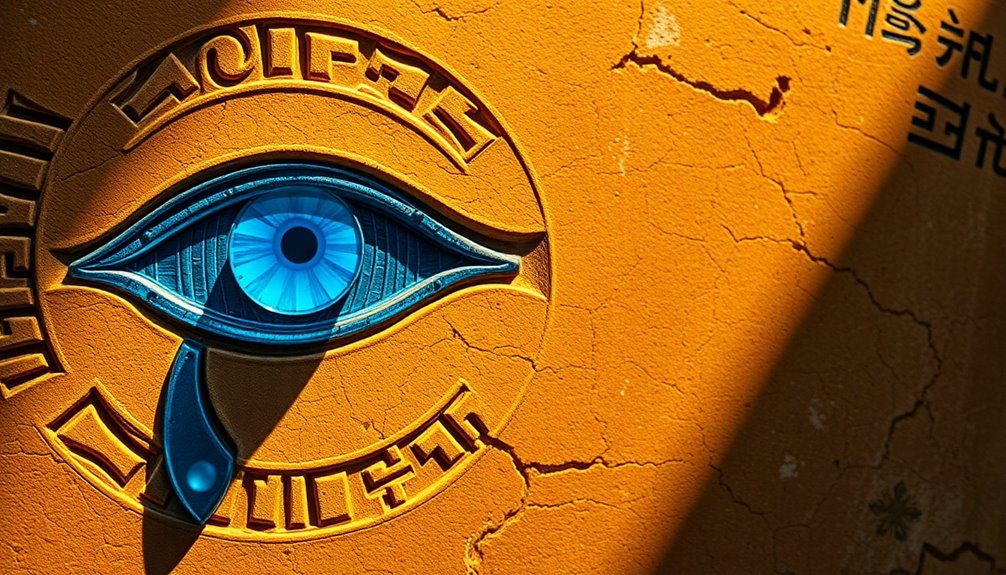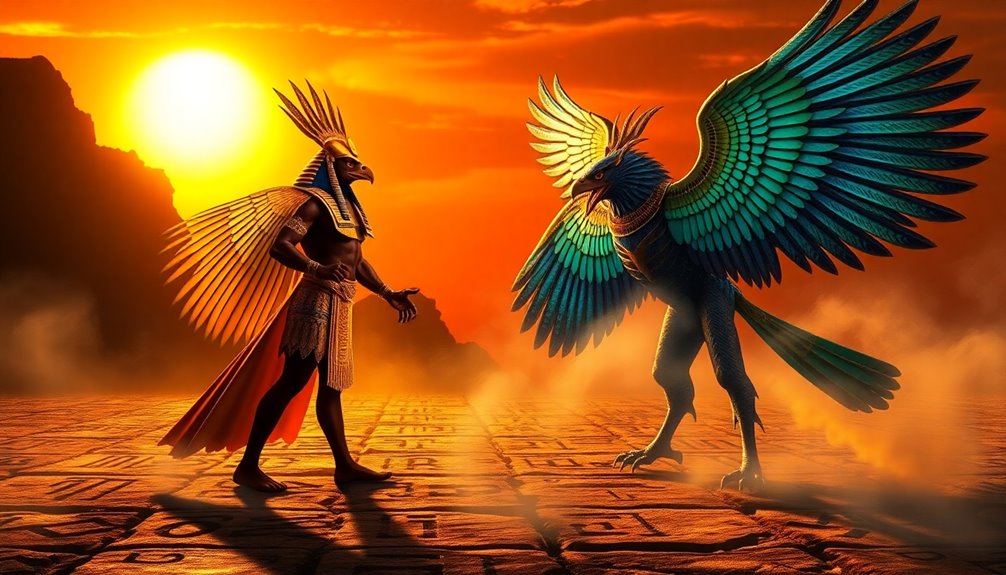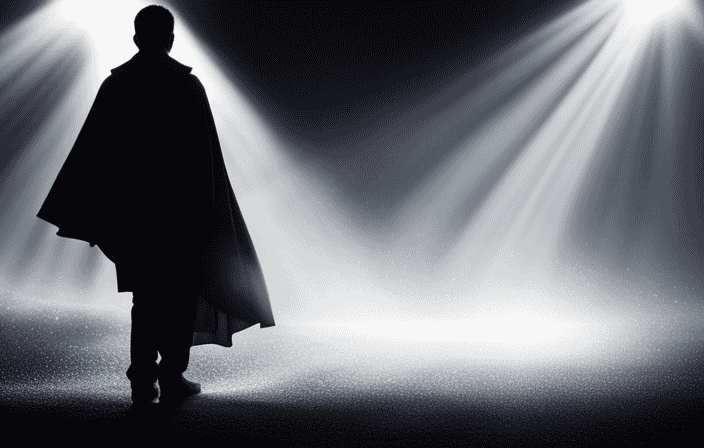Historians are baffled by the origins of the Eye of Horus, which symbolizes protection and healing in ancient Egypt. This emblem emerged over 4,000 years ago, rooted in the Osiris myth, representing the struggle between order and chaos. Its association with specific body parts adds to its mystery, linking divine protection to health and wellness. The intricate design, featuring unique elements like the distinct eyebrow and curling tail, captivates modern audiences and raises questions about its enduring power. If you're intrigued by how this ancient symbol has evolved through time, there's much more to discover about its significance and impact.
Key Takeaways
- The Eye of Horus originated in ancient Egypt, but its exact inception date and cultural influences remain uncertain, causing historical debate.
- Its association with the Osiris myth complicates its origins, as different interpretations of order and chaos influence its meaning.
- The adoption of the Eye by surrounding cultures like Syria and Nubia adds layers of complexity to its historical significance and origins.
- The symbol's unique features, such as the eyebrow and curling line, lack clear documentation on their initial meanings and purposes.
- Discrepancies in ancient texts and artifacts contribute to ongoing confusion regarding the Eye's original symbolism and its role in healing practices.
Symbolism and Meaning
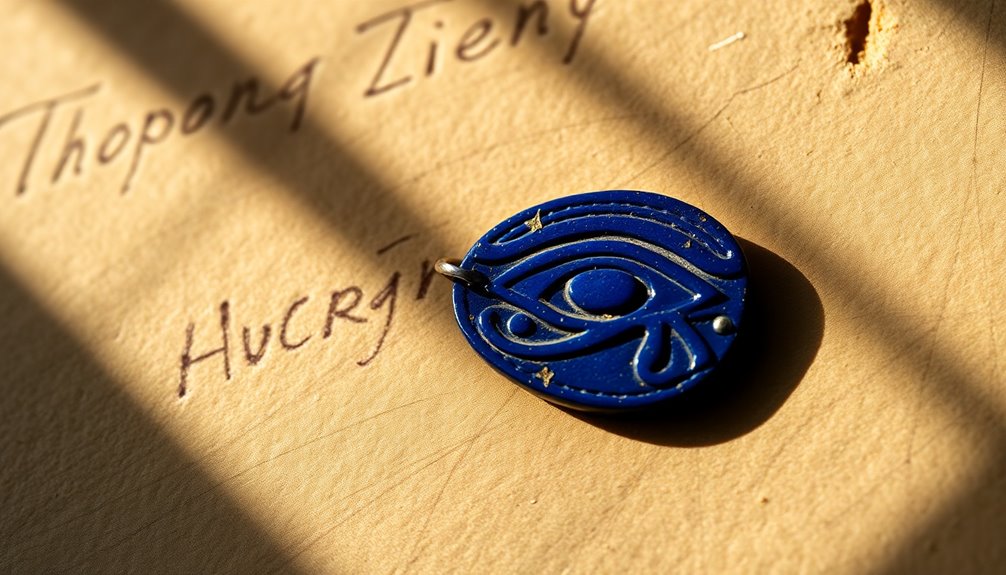
The Eye of Horus, with its rich symbolism, represents more than just a simple ancient Egyptian motif. It embodies protection, good health, and royal power, reflecting the ancient Egyptians' profound understanding of life and the human experience. Each part of the Eye corresponds to different senses—sight, smell, thought, hearing, and taste—showing how they viewed the interconnectedness of perception and existence.
This iconic symbol also tells the story of Horus's conflict with Set, emphasizing themes of healing and restoration. After his eye was damaged, its eventual restoration symbolized the cyclical nature of life, much like the phases of the moon.
The Eye of Horus, known as the wedjat, was integral in funerary practices, serving as a protective amulet for both the living and the deceased. This highlights its significance in ancient Egyptian beliefs about the afterlife.
Additionally, the mathematical representation of the Eye assigns fractions to its six parts, totaling 63/64, with the missing part symbolizing imperfection and the divine powers of Thoth. Through these layers of meaning, the Eye of Horus remains a powerful emblem of wholeness and resilience.
Historical Context
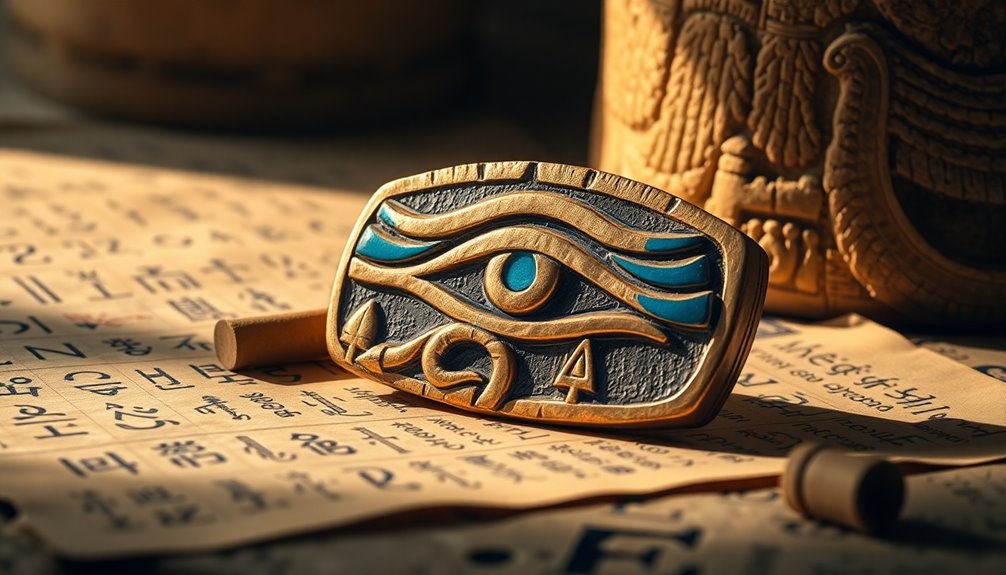
Dating back to ancient Egypt, the Eye of Horus has a rich historical context that underscores its enduring cultural significance. This symbol originated in the Old Kingdom and continued to be relevant through the Roman period, showcasing its long-lasting influence.
You'll find that the Eye first appeared on coffins during the First Intermediate and Middle Kingdoms, where it served as a funerary symbol, believed to offer protection in the afterlife.
The Eye of Horus was more than just a protective emblem; it was widely incorporated into amulets and jewelry, reflecting the ancient Egyptians' belief in its protective powers against evil and misfortune.
This symbol's relevance extended beyond Egypt, as neighboring cultures like Syria, Canaan, and Nubia adopted it, revealing its broader significance.
Throughout history, the Eye of Horus has been deeply linked to rituals and practices in temple worship and funerary customs.
Its connection to the ancient Egyptian god Horus further emphasizes its importance in Egyptian mythology.
Understanding this historical context helps to clarify why the Eye of Horus remains a powerful and enduring symbol in various cultures today.
Mythological Origins

While exploring the mythological origins of the Eye of Horus, you'll find that it's intricately tied to the Osiris myth. In this tale, Horus loses his eye in a fierce battle against Set, symbolizing the ongoing struggle between order and chaos, a core theme in Egyptian mythology. The restoration of Horus's eye, often attributed to the god Thoth, highlights healing and the cyclical nature of life, reminiscent of lunar phases.
The Eye of Horus not only represents resurrection but also protection, as Horus offers his eye to Osiris, linking it with the concept of life force and renewal. Curiously, the left eye is associated with the moon, while the right eye embodies the sun, showcasing the duality of day and night.
| Symbol | Associated Aspect | Significance |
|---|---|---|
| Eye of Horus | Horus | Protection and healing |
| Eye of Ra | Osiris | Life force and resurrection |
| Thoth | Restoration | Healing and renewal |
Through these narratives, the Eye of Horus emerges as a powerful emblem in ancient Egyptian culture.
Artistic Representations
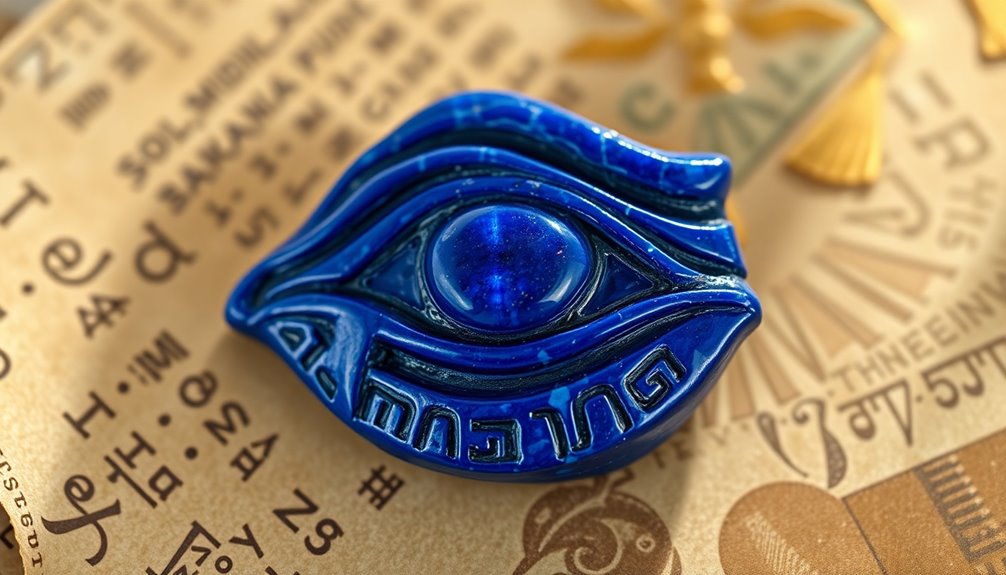
When you look at the Eye of Horus, you can't help but notice its unique symbolic features, like the distinct eyebrow and curling line.
You'll find this iconic symbol in various artistic forms, from wall paintings to sculptures, showcasing its cultural significance across centuries.
Its influence even extends to contemporary art, proving that the Eye of Horus remains a powerful emblem of protection and identity.
Symbolic Artistic Features
The Eye of Horus stands out in ancient Egyptian art for its unique symbolic features. With its distinctive markings, including an eyebrow, a dark cheek line, and a curling tail, this symbol reflects Horus's avian nature, resembling a falcon. Each aspect of the design serves not only aesthetic purposes but also conveys meanings related to protection and healing.
| Feature | Symbolic Meaning |
|---|---|
| Eyebrow | Vision and awareness |
| Dark cheek line | Protection from harm |
| Curling tail | Life and liveliness |
| Hieroglyphic elements | Individualized meanings |
| Overall design | thorough safeguard |
In artistic representations, the Eye of Horus frequently appears in wall paintings, sculptures, and jewelry. It's often used in amulets, acting as a protective talisman for the living and the deceased alike. Additionally, the symbol's presence on the bows of boats signifies guidance and protection for sailors, emphasizing its practical application in ancient artistry. Through these symbolic artistic features, the Eye of Horus remains a powerful emblem of protection in ancient Egyptian culture. This symbol also embodies transformation and enlightenment, reflecting its deep spiritual significance beyond mere artistry.
Common Depictions and Mediums
Artistic representations of the Eye of Horus showcase its significance across various mediums in ancient Egyptian culture. You'll often find this stylized eye symbol featuring distinct elements like an eyebrow, a dark line, a cheek marking, and a curling line that resembles a falcon's features.
These representations appear in wall paintings, sculptures, and papyrus scrolls within ancient Egyptian tombs and temples, emphasizing its importance alongside other deities and symbols.
The Eye of Horus also manifests in the form of *Wedjat* eye amulets, which gained popularity during the late Old Kingdom. Crafted from materials like gold, lapis lazuli, and carnelian, these amulets highlight the symbol's protective significance.
You might notice the Eye of Horus painted on the bows of boats, serving as a talisman for safe passage. Additionally, temporary amulets were often drawn on linen or papyrus to provide specific protection and guidance.
Through these diverse artistic representations, the Eye of Horus not only reflects the deep cultural and religious beliefs of ancient Egyptians but also serves as a powerful emblem of protection and divine favor.
Cultural Influence on Art
Throughout history, countless artists have drawn inspiration from the Eye of Horus, reflecting its enduring cultural significance. This ancient Egyptian symbol, often depicted in art, embodies protection and insight, making it a powerful motif across various contexts.
You can see its influence in several ways:
- Funerary Art: The Eye of Horus frequently appears on tomb walls, coffins, and temples, emphasizing its role in ensuring safe passage to the afterlife.
- Amulets: From the late Old Kingdom onward, artisans crafted *wedjat* eye amulets in materials like gold and lapis lazuli, showcasing the symbol's importance in personal protection and adornment.
- Maritime Culture: Artists painted eyes on boat bows to offer protection and guidance during voyages, demonstrating the practical application of the Eye of Horus.
- Contemporary Interpretations: Today, the Eye of Horus continues to inspire modern art and design, illustrating its lasting cultural influence beyond ancient Egyptian contexts.
The Eye of Horus remains a vibrant symbol, bridging ancient beliefs with contemporary artistic expressions, ensuring its relevance across time and cultures. Additionally, similar to the way Indonesian decor masks reflect cultural heritage, the Eye of Horus showcases the power of symbols to convey deep meanings through art.
Modern Interpretations
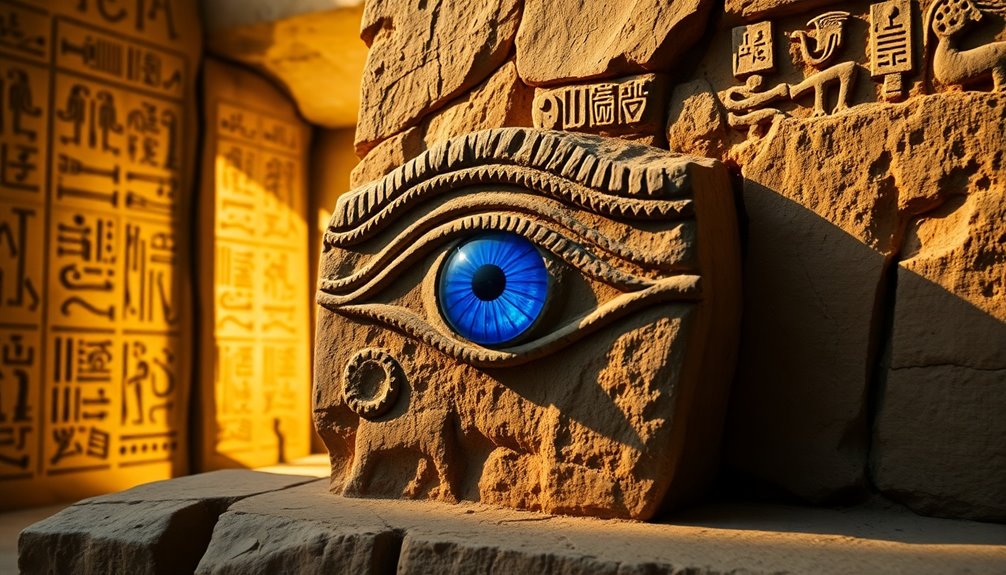
Today, the Eye of Horus stands as a powerful cultural symbol, representing protection and strength in various forms of modern design.
You'll notice its significant ties to healing and restoration, rooted in ancient beliefs about safeguarding against ailments.
As you explore its contemporary meanings, the symbol's enduring legacy becomes even more fascinating.
Cultural Symbolism Today
The Eye of Horus remains a powerful cultural symbol that resonates in modern branding and design, reflecting its ancient roots in protection and strength.
You'll find this emblem widely used, showcasing its enduring significance in various contexts. The Eye of Horus connects to themes that promote well-being and restoration, echoing its historical importance in ancient Egyptian culture.
Here are four ways the Eye of Horus is interpreted today:
- Brand Identity: Companies incorporate the symbol to communicate strength and reliability, appealing to consumers' desire for protection.
- Artistic Expression: Artists use the Eye in contemporary pieces, paying homage to its rich cultural symbolism and historical narratives.
- Jewelry Designs: Many jewelers feature the Eye of Horus in their collections, signifying protection and well-being for the wearer.
- Cultural Appreciation: The symbol serves as a bridge between ancient Egyptian traditions and modern global culture, fostering interest in historical meanings.
In various forms, the Eye of Horus continues to captivate and inspire, making it a timeless emblem of restoration and strength.
Healing and Protection Significance
In ancient Egypt, the Eye of Horus was seen as a powerful emblem of healing and protection, and its significance hasn't faded in modern interpretations. This ancient symbol, often linked to restorative powers, played an essential role in healing rituals. Practitioners equated patients with Horus, invoking the eye's energy to promote recovery and safeguard health.
Here's a concise overview of the Eye of Horus's associations:
| Aspect | Description | Modern Influence |
|---|---|---|
| Healing | Used in spells to cure ailments, especially eye diseases | Used in wellness products |
| Protection | Guarded against illness and misfortune | Popular in jewelry designs |
| Body Parts | Associated with specific body parts for safeguarding health | Seen as a talisman for well-being |
Today, the Eye of Horus resonates with many who seek healing and protection. Its historical roots in ancient Egyptian culture continue to inspire contemporary interpretations in art and fashion, reflecting a timeless desire for strength and safety. As scholarly research evolves, the Eye of Horus remains a potent symbol of healing and protection in your life. Furthermore, the subconscious power of symbols like the Eye of Horus can enhance one's overall wellness and manifestation practices.
Healing Practices
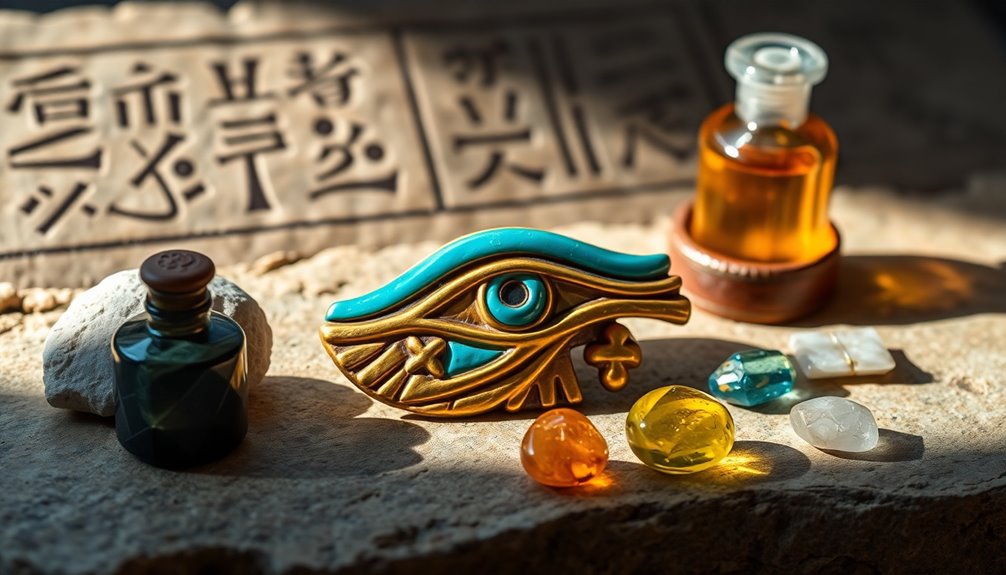
Healing practices in ancient Egypt were deeply intertwined with spiritual beliefs, particularly through the invocation of the Eye of Horus. This powerful symbol represented not just protection but also the restorative powers of the deity Horus.
When you think about ancient Egyptian healing rituals, consider how they employed the Eye of Horus in several significant ways:
- Healing Spells: The Eye of Horus was frequently invoked in spells aimed at treating eye diseases and promoting overall health.
- Divine Connection: Patients were often equated with Horus during healing rituals, facilitating recovery by leveraging the god's restorative attributes.
- Papyrus Leiden I 348: This ancient text links various body parts to deities, highlighting the left eye's connection to Horus for healing.
- Protective Amulets: The Eye of Horus served as a protective amulet, believed to ward off ailments and guarantee the well-being of both the living and the deceased.
These practices combined practical treatments with divine rituals, underscoring the Eye of Horus's integral role in the holistic approach to health and restoration in ancient Egypt.
Frequently Asked Questions
What Was the Original Meaning of the Eye of Horus?
The Eye of Horus originally symbolizes wholeness and protection.
When you look at it, you see its connection to the restoration of Horus's eye after his battle with Set. Each part represents different senses, and together they convey themes of life, death, and rebirth.
You'll find it frequently used in funerary practices, believed to guard both the living and the dead from evil influences, making it an essential symbol in ancient Egyptian culture.
What Does the Bible Say About the Eye of Horus?
The Bible doesn't mention the Eye of Horus at all. This ancient Egyptian symbol is rooted in mythology, focusing on the conflict between Horus and Set, which isn't part of biblical narratives.
While it embodies themes like protection and healing, similar to some biblical concepts, they don't intersect directly.
If you're exploring symbols within the Bible, you'll find different representations and teachings that align more closely with its own religious framework.
Is the Eye of Horus Good or Bad?
Did you know that over 80% of ancient Egyptians used the Eye of Horus as a protective amulet?
You'll find it's primarily seen as a symbol of good rather than bad. This emblem represents protection, healing, and royal power, contrasting sharply with its adversary, Set.
It embodies renewal and the senses, promoting well-being and safeguarding against evil.
What Is the Original Story of Horus?
The original story of Horus revolves around his battle for revenge against Set, who killed his father, Osiris.
As you immerse yourself in the myth, you'll see Horus losing his eye during this fierce conflict.
However, that eye gets restored, symbolizing healing and protection.
Horus, as a sky deity, represents duality, with his left eye linked to the moon and the right to the sun, embodying the cyclical nature of life and renewal.
Conclusion
In unraveling the Eye of Horus, you step into a world where history, myth, and art intertwine like threads in a tapestry. This ancient symbol, rich in meaning and mystery, invites you to ponder the depths of human belief and creativity. As you explore its healing powers and modern interpretations, remember that its gaze still watches over us, a timeless reminder of resilience and protection in an ever-changing world. Embrace the enigma—it's a journey worth taking.
